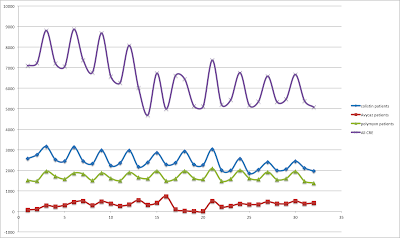Many thanks to Alan Carr of Needham & Co. in New York
for providing the IMS data I needed to look at the question of price perversion
in the antibiotic marketplace that I discussed in my last blog.
The chart below is based entirely on IMS sales data for the
US that has been converted into prescription data. As such, it has its limitations. The data
starts with the April 2015 US launch of Avycaz. Nevertheless, we can see that
the overall treatment of carbapenem-resistant Gram negative infections has
decreased since late 2016 – consistent with data showing a
decrease in KPC Klebsiella infections during this time.
The graph shows that there are 7-9000 CRE infections treated
each month in the US and that these numbers decreased starting in mid-2016.
Colistin and polymyxin appear to be used for about half of the total patients
even after the launch of Avycaz. Avycaz is used to treat about 2000 patients
per month. The rest are treated with
tigecycline or other drugs or drug combinations not including colistin,
polymyxin or Avycaz. The fact that Av
 Even though these data are limited by the extrapolation from
sales to prescriptions and from the weakness of hospital recording for these IMS
data, they are still likely to show real trends in therapy. And that, my friends and colleagues, is
discouraging. We should be doing all in our
power to avoid
treating sick patients with colistin/polymyxin regardless of antibiotic
price!
Even though these data are limited by the extrapolation from
sales to prescriptions and from the weakness of hospital recording for these IMS
data, they are still likely to show real trends in therapy. And that, my friends and colleagues, is
discouraging. We should be doing all in our
power to avoid
treating sick patients with colistin/polymyxin regardless of antibiotic
price!
No comments:
Post a Comment